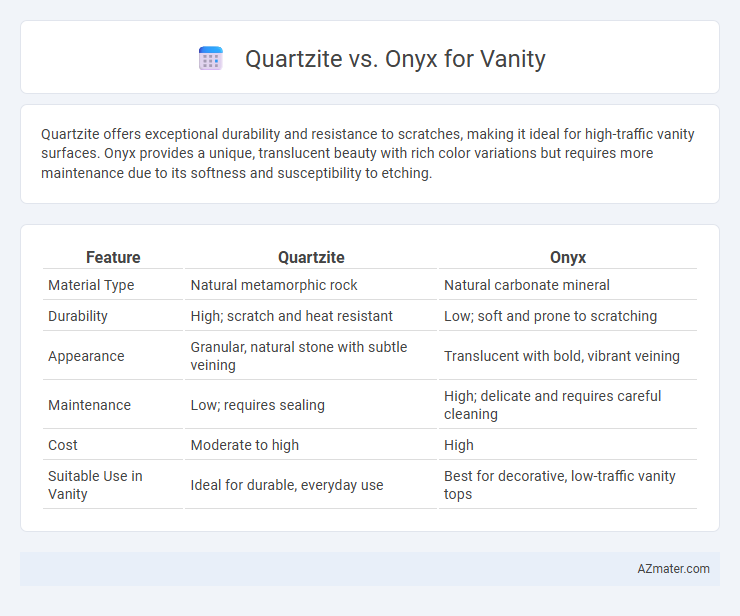Quartzite offers exceptional durability and resistance to scratches, making it ideal for high-traffic vanity surfaces. Onyx provides a unique, translucent beauty with rich color variations but requires more maintenance due to its softness and susceptibility to etching.
Table of Comparison
| Feature | Quartzite | Onyx |
|---|---|---|
| Material Type | Natural metamorphic rock | Natural carbonate mineral |
| Durability | High; scratch and heat resistant | Low; soft and prone to scratching |
| Appearance | Granular, natural stone with subtle veining | Translucent with bold, vibrant veining |
| Maintenance | Low; requires sealing | High; delicate and requires careful cleaning |
| Cost | Moderate to high | High |
| Suitable Use in Vanity | Ideal for durable, everyday use | Best for decorative, low-traffic vanity tops |
Introduction: Quartzite vs Onyx for Vanity Tops
Quartzite offers exceptional durability and scratch resistance, making it ideal for high-traffic vanity tops, while onyx provides a luxurious, translucent appearance with unique veining patterns that enhance aesthetic appeal. Quartzite's natural hardness and heat resistance outperform onyx, which requires more maintenance due to its softer, porous nature. Selecting between quartzite and onyx for vanity tops depends on whether strength or visual impact is the priority in bathroom design.
What is Quartzite? Key Features and Benefits
Quartzite is a natural metamorphic rock formed from sandstone subjected to intense heat and pressure, resulting in a highly durable and dense surface ideal for vanity countertops. Key features include exceptional hardness, resistance to scratches and heat, and a unique, natural, crystalline appearance with subtle veining that enhances bathroom aesthetics. Benefits of quartzite for vanities encompass long-lasting durability, minimal maintenance compared to softer stones like onyx, and the ability to withstand daily wear while maintaining its polished finish.
What is Onyx? Distinctive Attributes Explained
Onyx is a translucent, banded natural stone known for its striking, swirling patterns and vibrant colors, often used for decorative purposes in vanity tops. Its unique translucency allows backlighting, creating a luxurious and dramatic visual effect that sets it apart from quartzite, which is more durable and commonly used in high-traffic areas. Despite being softer and more prone to etching and scratching than quartzite, onyx's distinctive aesthetic appeal makes it a favored choice for stylish, statement vanity installations.
Appearance: Color, Patterns, and Veining
Quartzite offers a natural stone appearance with a wide range of colors from white and grey to pink and green, featuring subtle, consistent veining that resembles marble. Onyx stands out with its translucent quality, vibrant colors such as amber, green, and red, and dramatic, bold patterns with striking veining that creates a luxurious, eye-catching vanity surface. The choice depends on whether you prefer quartzite's durability with classic elegance or onyx's unique, luminous aesthetic for a stunning visual impact.
Durability: Strength and Longevity Comparison
Quartzite offers exceptional durability for vanity tops, boasting a high resistance to scratches, heat, and stains due to its natural quartz composition, making it ideal for long-term use. Onyx, while visually stunning with its translucent and unique veining, is significantly softer and more prone to scratching, chipping, and etching, which can reduce its longevity in high-traffic bathroom areas. For homeowners prioritizing strength and enduring performance, quartzite is the superior choice over onyx for vanity surfaces.
Maintenance and Care Requirements
Quartzite offers superior durability and resistance to scratches, stains, and heat, requiring minimal maintenance with regular sealing to protect its natural stone surface. Onyx, being softer and more porous, demands careful upkeep, including gentle cleaning with non-abrasive products and frequent sealing to prevent etching and discoloration. For vanity surfaces, quartzite's low-maintenance properties make it a practical choice, while onyx provides a luxurious look that necessitates more diligent care.
Stain and Scratch Resistance
Quartzite offers exceptional stain and scratch resistance due to its natural hardness and dense composition, making it a durable choice for vanity surfaces in high-use bathrooms. Onyx, while visually striking with its translucent and colorful patterns, is softer and more porous, making it prone to scratching and staining without proper sealing and careful maintenance. Choosing quartzite guarantees a low-maintenance, long-lasting vanity top that withstands daily wear better than the delicate onyx.
Cost Analysis: Quartzite vs Onyx
Quartzite typically costs between $60 and $100 per square foot, making it more budget-friendly compared to onyx, which ranges from $80 to $200 per square foot due to its rarity and unique translucence. The installation expenses for quartzite are moderate, while onyx requires specialized handling and lighting installation, increasing overall costs. Maintenance costs for quartzite are generally lower since it is more durable and less prone to scratching or etching than onyx, which demands regular sealing and careful upkeep to preserve its appearance.
Best Applications: Suitability for Vanity Spaces
Quartzite offers exceptional durability and resistance to scratches and heat, making it ideal for high-traffic vanity spaces that require long-lasting surfaces. Onyx, with its translucent beauty and unique veining, suits vanities where aesthetic appeal and softer use are prioritized, typically in low-traffic or decorative bathroom settings. Both materials enhance vanity spaces, but quartzite is best for robust daily use, while onyx excels in visual impact and luxury design.
Final Verdict: Which is Better for Your Vanity?
Quartzite offers superior durability and resistance to scratches and heat, making it ideal for high-traffic vanity surfaces; its natural stone aesthetics provide a sophisticated look with minimal maintenance. Onyx, while stunning with its translucent beauty and unique veining, requires more care and is softer, prone to scratches and etching, which may limit its practicality for daily use. Choosing quartzite ensures a long-lasting, low-maintenance vanity surface ideal for busy bathrooms, whereas onyx suits those prioritizing luxury and visual impact over durability.

Infographic: Quartzite vs Onyx for Vanity
 azmater.com
azmater.com